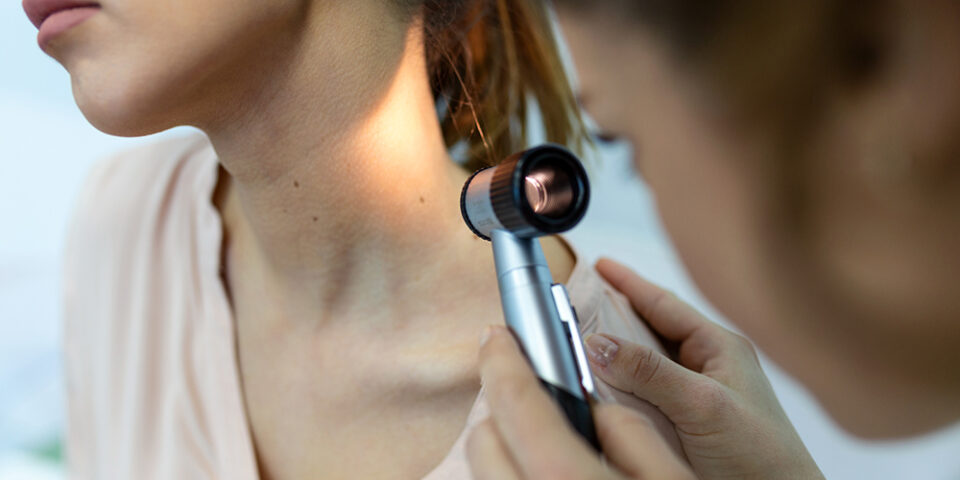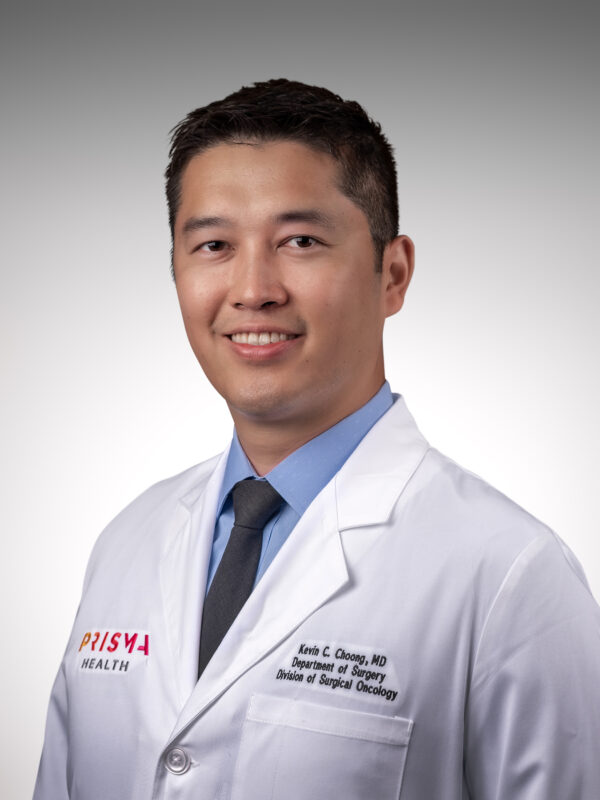Treating and preventing melanoma
Is it a mole or a melanoma? Does it look a little different than before? These are questions you may be asking when it comes to skin cancer known as melanoma. Surgical oncologist Kevin Choong, MD, shares some important tips, including when to see a doctor about a suspicious mole.
Transcript
Joey Wahler (Host): It’s a form of cancer that can be deadly, but it’s also treatable and preventable. So, we’re discussing melanoma. Our guest, Dr. Kevin Choong. He’s a surgical oncologist with Prisma Health Cancer Institute.
Host: This is Flourish, a podcast from Prisma Health. Thanks for listening. I’m Joey Waller. Hi there, Dr. Choong. Thanks for joining us.
Dr. Kevin Choong: Hi, Joey. Thank you for having me.
Host: Great to have you with us. So, first, for those that don’t know, what in a nutshell is melanoma and what typically causes it?
Dr. Kevin Choong: So, melanoma is a type of skin cancer developing from melanocytes, which are the pigment-producing cells of the skin. This can occur anywhere on the surface of the body; however, it is most commonly seen in the chest and back of men and legs of women. Melanomas are usually brown or black, but can also be pink, tan, or white. General characteristics are best remembered by the mnemonic ABCDE, standing for asymmetry; borders, which are irregular; color, which is not evenly colored; diameter, which is larger than six millimeters or about the size of the eraser on a pencil; and evolving, meaning changing color, shape or size with time.
Host: Now, having said that, if someone sees something on their skin that doesn’t look right, they should see a doctor, right?
Dr. Kevin Choong: That is very accurate. Yes. Either seeing your primary doctor who can manage it initially themselves, or they can refer you to a dermatologist or a skin specialist.
Host: Gotcha. So, can those with darker skin still get skin cancer?
Dr. Kevin Choong: Yes. So although high amounts of melanin, which is the protein produced by the melanocytes, is protective against ultraviolet radiation, people with dark skin can get skin cancer. And this is particularly in areas like the palms of the hands or soles of the feet and under the nails, which lack pigmentation.
Host: Interesting. So, how can we ourselves help to prevent melanoma?
Dr. Kevin Choong: So, melanoma is caused by UV radiation, and this is most commonly due to sun exposure. This causes damage to the cells and their DNA, ultimately causing a cancer. So, the best way to prevent a melanoma is to prevent exposure to UV radiation. And what that can involve is avoiding sun exposure in general or using a combination of finding shade, wearing protective clothing or applying sunscreen.
Host: Okay. So speaking of sunscreen, a few questions about that. First, how does it actually provide protection in the first place?
Dr. Kevin Choong: So, while there are many different types of brands of sunscreens, generally their active components fall into two major categories. These are either UV blockers or UV absorbers. And so, the way that it works is that you apply it as instructed to your skin, and this can either block or absorb the radiation to prevent the damage to your cells.
Host: And you mentioned there are two types.
Dr. Kevin Choong: Yes. So, the UV blockers are typically the thicker creams that contain something along the lines of zinc oxide or titanium oxide that leave kind of like a permanent white layer over your skin. And the absorbers are the ones that, as you apply, generally as you rub them in, they become clear. And these can contain a variety of different compounds that can absorb the radiation.
Host: So, you mentioned the two types of sunscreen. Is one more effective than the other?
Dr. Kevin Choong: So while there are two different types of sunscreens, one is not necessarily more effective than the other. Whenever you go to the store and you buy a sunscreen, generally on the bottle you’ll see something that says SPF or sun protection factor. In a laboratory setting, the higher the SPF, the longer it would take for the same amount of sun to cause a sunburn. However, oftentimes from a practical standpoint, how you use it is more important than what is contained within it.
Host: Meaning what exactly?
Dr. Kevin Choong: So, when you use sunscreens as directed, the first important thing is to cover your entire sun-exposed skin with the sunscreen. Some common mistakes when applying sunscreen are missing those hard-to-reach areas, particularly on the back which you’re not able to reach. One way of combating this is to have someone else help you when applying the sunblock.
The second most common mistake is not reapplying the sunscreen as directed. In general, it is typical to reapply the sunscreen every two hours. However, certain activities such as swimming, sweating or toweling off can increase the rate at which the sunblock comes off of the skin. And as a result, you need to reapply more frequently to allow for ongoing protection.
Host: Gotcha. Good advice there. One more on sunscreen. Can we use it if it’s expired, which I’m sure many of us have somewhere around the house? And can sunscreen ever be bad for us?
Dr. Kevin Choong: So, it is not recommended to use expired sunscreen as some of the active ingredients may have degraded and no longer be as effective. Now, with regard to can it be bad for you, so there are some anecdotal descriptions of potential toxicities from. The components of sunscreen, particularly if you look online, things like neurotoxicity, vitamin D deficiency or some endocrine dysfunction. However, there is no strong evidence to suggest significant toxicity with the routine use of sunscreen. One particular group of patients that generally is not recommended to use sunscreen on are children less than six months of age.
Host: Interesting. Okay. So, no sunscreen for infants until they’re seven months and older, yeah?
Dr. Kevin Choong: Correct.
Host: Okay. How about protective clothing designed to block the rays of the sun, whether because of the fabric or because of the color? Is that more effective than sunscreen or not?
Dr. Kevin Choong: So, the amount of protection that clothing provides can be quite variable. The typical clothing that we wear with natural fabrics such as cotton or loosely woven clothing generally allows more UV light to pass through. As a result, doesn’t provide much benefit. Darker, tightly woven and synthetic fibers generally provide better protection.
Additionally, you know, there is specific UV protective clothing that is available. And when this is worn correctly, they can provide benefit than sunscreen, mainly because you don’t have to worry about reapplying the sunscreen.
Host: Certainly makes sense. Okay, doc, switching gears, if someone does get melanoma, how is it usually treated?
Dr. Kevin Choong: So melanoma, as with most cancers, is treated with what we call multimodal therapy. So in general, what happens is that if there’s a skin lesion that is abnormal, it’s biopsied to establish a diagnosis. And then depending on the stage, this is subsequently excised with some wider margins with or without a lymph node evaluation. And then depending on the stage of the disease, systemic therapy, specifically immunotherapy, can be used to help treat the melanoma.
Host: And if there’s immunotherapy used, how does that basically work?
Dr. Kevin Choong: So, immunotherapy is a broad category of treatments that allows the immune system to fight cancers. Specifically for melanoma, the immunotherapeutics used are something called checkpoint inhibitors, which come under the generic names of nivolumab, pembrolizumab or ipilimumab. So, tumors express signals that activate the brakes or checkpoints onto immune cells, and these inhibitors effectively take off the brakes so that immune cells can better fight the melanoma.
Host: Gotcha. Couple other things. If you do have melanoma and it is treated, what’s the cure rate typically?
Dr. Kevin Choong: So, the cure rate can be variable and it really depends on the stage. In terms of early stage melanomas, like stage I or II melanomas, cure rate can be quite good. Now once it has spread to the lymph nodes, cure rate can be more challenging. However, there are evolving therapies in terms of the use of immunotherapy either before or after surgery that can increase your cure rate. Once you get to stage IV cancer, which is spread of the melanoma to distant organs, cure rate is not as likely, however can be quite manageable with immunotherapy.
Host: Okay. So in summary here, how often should the average person have their skin checked by a doctor, and who among us is most vulnerable to melanoma so that maybe we need to do it more often than the norm?
Dr. Kevin Choong: While there is a general lack of strong evidence to help guide us on the frequency of skin checks, society guidelines, such as a dermatologist guidelines, as well as the US Preventative Services Task Force, generally recommend annual skin checks. For those who are at higher risk, potentially more frequent skin checks are needed. Higher risk individuals include those with light skin, blonde or red hair, multiple nevi or moles, multiple freckles, as well as a family history or personal history of skin cancers.
Host: And last thing real quick, when you do apply sunscreen, you should wait like 20 minutes to a half hour before you go out in the sun with it, right?
Dr. Kevin Choong: That’s generally a good practice to make sure that the sunscreen is adherent to your skin before you go out into the sun.
Host: It takes a lot of work, doctor, if you want to get that nice tan, doesn’t it?
Dr. Kevin Choong: You know what, yes. Tans are nice, but sometimes there’s a price to pay, which is oftentimes much further down the road.
Host: Yes, no question. Well, folks, we trust you are now more familiar with treating and preventing melanoma. Dr. Kevin Choong, thanks so much again.
Dr. Kevin Choong: Thanks again for having me.
Host: And for more information, please visit PrismaHealth.org/Flourish. Again, PrismaHealth.org/Flourish. Now, if you found this podcast helpful, please do share it on your social media. And thanks again for listening to Flourish, a podcast from Prisma Health. Hoping your health is good health. I’m Joey Wahler.
Read MoreFind a doctor
Whether you’re looking for a primary care physician or need to see a specialist, we’re here to help with experienced, compassionate care near you.
Find a Doctor

